Dion Phaneuf was a great hockey player, but at one time he had a bad ‘reputation’ (from ‘Sleepy PEI town braces for celebrity storm as Toronto Maple Leafs Captain Dion Phaneuf prepares to wed Canadian actress Elisha Cuthbert’, National Post, 05/07/2013). My wife and I used to own a summer home in Prince Edward Island (PEI) and we often heard stories about his antics during the summers he spent on the Island in his youth.
I don’t know if these stories are true or simply the talk of Islanders who may begrudge his success. All I can do is recount what I know of Phaneuf and what it says about the character on which he built a storied 15-year career in the NHL.
Related: Dion Phaneuf: the Most Unfairly Lambasted Player in the NHL
I had seen Phaneuf a few times at Andersons Creek Golf Club in Stanley Bridge, PEI and was always struck by how approachable he was, smiling and making eye contact with everyone; he made it easy for you to strike up a conversation.
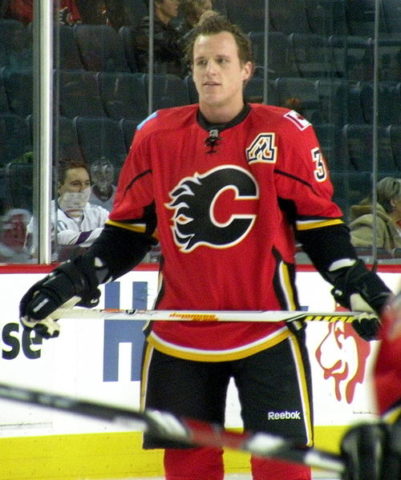
Phaneuf has deep roots in PEI. Both his parents were born there. While native to Calgary, his extended family is still there and his aunt was the Attorney General in the province for a few years. Phaneuf’s wedding to Hollywood actor Elisha Cuthbert was PEI’s social event of the summer in 2013, bringing so much hockey royalty to the island that, rumour had it, there was a shortage of hotel rooms.
I think the character that has shaped PEI is reflected in Phaneuf’s NHL career – determination, strength of character, hard work and perseverance. Like his fellow Islanders, Phaneuf has combined these traits with “pugnacity, testosterone, truculence and belligerence” when it was required on the ice (from ‘Where’s the truculence, Burke?’, Toronto Sun, 26/02/2012).
Early Days with the Red Deer Rebels
Phaneuf spent his entire junior career with the Western Hockey League’s (WHL) Red Deer Rebels. Entering the league directly from Bantam in the 2001-02 season, the big defenseman made his presence felt immediately. Scouts took notice of his strong defensive and offensive abilities and noted his tough, physical play which drew comparisons to Scott Stevens.
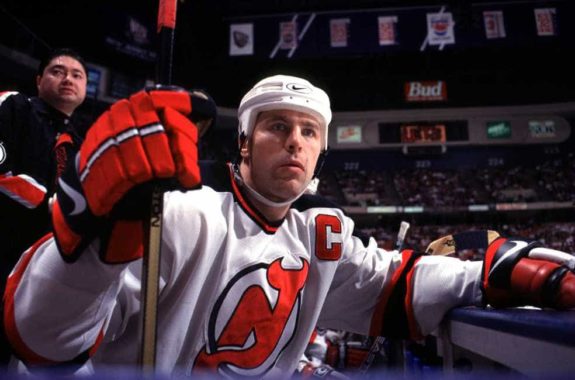
Calgary selected him ninth overall in the 2003 NHL Entry Draft after which he lit the WHL on fire, eager to prove to the Flames that they had made the right choice. In the 2003-04 WHL season, he was named the league’s top defenseman and to both the WHL and CHL All-Star Teams. Hockey writers rated him as the top player in the CHL ahead of Sidney Crosby. A callup to the big club for the 2004-05 season was put on the back burner because of the NHL lockout.
The Flames Years
A 20-year-old Phaneuf slid a Flames sweater over his head and began his NHL career in October 2005. Most prospects who play in junior, even those considered elite, spend several years playing for their team’s minor league affiliate before signing an NHL contract. Few 20-year-olds have the poise and polish needed to make the transition directly from junior to the NHL.
Phaneuf made a splash in November of his rookie season, scoring nine points and two game-winning goals to earn NHL Rookie of the Month honours. His name was mentioned in the same breath as Alex Ovechkin and Crosby as a candidate for the Calder Memorial Trophy (eventually awarded to Ovechkin).
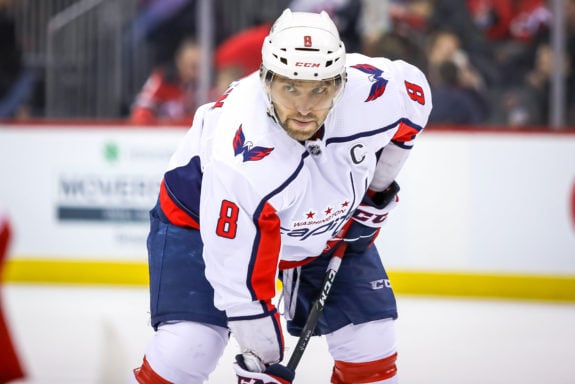
Phaneuf’s second season saw him rack up 50 points and win a spot in the NHL All-Star Game. His spectacular performance since his debut garnered a six-year $39 million contract extension midway through the 2007-08 season. As one of the building blocks toward another Stanley Cup in Calgary, Phaneuf notched 60 points that season and he was nominated for the Norris Trophy as the league’s top defenseman – he lost out to the Detroit Red Wings’ Niklas Lidstrom.
The 2008-09 season was as disappointing for Phaneuf as it was for the Flames. With just 11 goals and a minus-11 rating, fans began to turn on the young star. Rumours were rampant that given his high salary and mediocre performance, he would be traded. Flames management defended Phaneuf, blaming his lacklustre season on a hip injury. They explained his inability to dress for a pivotal Game 6 in a losing effort against the Chicago Blackhawks in the Western Conference Quarter-Final to two broken ribs.
Fans with reckless wishes should take heed – sometimes they come true. The Flames dealt Phaneuf to the Toronto Maple Leafs in Jan. 2010. What led up to the trade is the question that has fuelled countless barstool debates in Cowtown. Why did the Flames suddenly throw away a rising 24-year-old star? Why didn’t the Flames stick by him after just one disappointing season?
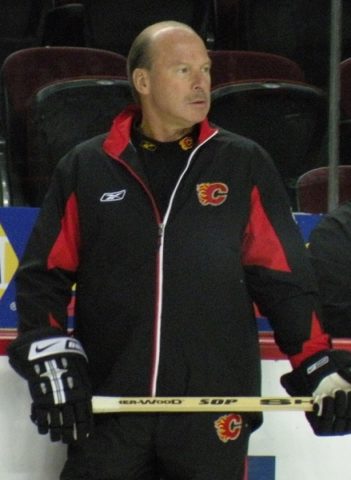
There are two schools of thought. The first maintains that Phaneuf had a problem in the dressing room. HFBoards and other blogs speculated that he did not get along with head coach Brent Sutter. To be fair, many speculated that Sutter also had problems with other players.
Asked about Phaneuf, Mike Keenan, Brent Sutter’s immediate predecessor, in an interview with TSN in late 2010 on the day Phaneuf returned to Calgary for the first time as Leafs captain, called Phaneuf – ‘Neon Dion’. Keenan spoke openly about the young star’s problems in the dressing room during his time as head coach explaining that his ‘overly confident, if not cocky behaviour rubbed some Flames veterans the wrong way.’ Phaneuf would not be the first arrogant young star to play in the NHL, so why couldn’t the Flames find a way to take the rough edges off this rare diamond?
The other school of thought contends that trading Phaneuf was one of the last desperate moves by general manager Darryl Sutter and his brother Brent. Right before Phaneuf was traded the team had lost 10 games in a row, their offense was horrendous and their power play was inept, ranked 22nd and 23rd in the league respectively.
The team was desperately trying to make the playoffs for the first time since 2004 when they reached the Stanley Cup Final. The Flames’ dismal performance early in the season had many fans lighting their hair on fire who believed that the team should be doing much better with Miikka Kiprusoff in goal, and Jay Bouwmeester, Robyn Regehr, Mark Giordano and Phaneuf on the blue line.
Related: Flames Have it Rough, But Better Than Most Hockey Markets
Sure, Darryl Sutter picked up Matt Stajan in the Phaneuf trade, but in Calgary, he never consistently racked up the point totals that he did with the Leafs. Niklas Hagman, also part of the trade, was expected to boost Calgary’s firepower but he didn’t match his Leafs performance either. Ian White and Jamal Mayers, the other two players picked up in the Phaneuf trade were disappointments and gone by the end of 2010.
You may also like:
- Flames & Maple Leafs Trade History Revisited
- Calgary Flames’ 2024-25 Bounce Back Candidates
- Flames Will Be Elite Team When New Arena is Built
- NHL Rumors: Blue Jackets, Oilers, Flames, Senators
- Top Contenders for 2025 Calder Trophy
Many were not surprised that this was all the Sutter brothers managed to get in return for a star like Phaneuf given their well-chronicled ineptitude as managers of the Flames. Barely more than 11 months after trading Phaneuf away, Darryl Sutter resigned as GM, his only real success having been coaching the Flames to the Stanley Cup final in 2004. Younger brother Brent’s coaching contract was not renewed when it ended in 2012 and he never coached in the NHL again.
The Phaneuf trade is regarded as one of the worst in Flames history which says as much about management incompetence as it does about their lack of vision. Phaneuf should never have slipped through the team’s fingers.
The Toronto Maple Leafs
During the seven seasons that Phaneuf played for the Maple Leafs, the team was so dreadful that had Jesus Christ himself laced up his skates for the team they probably wouldn’t have made the playoffs. Only once during Phaneuf’s tenure was their golf season threatened by an appearance in the postseason. That was in 2013 when the Maple Leafs, after clawing their way back from a 3-1 deficit in their quarter-final series against the Boston Bruins, blew a 4-1 lead in the third period of Game 7 to lose the series.
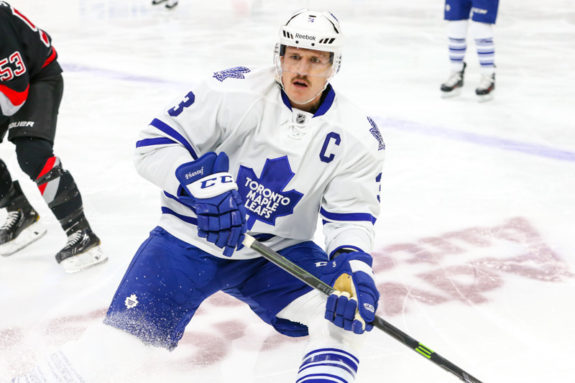
Phaneuf was named Maple Leafs captain at the end of his first season in 2010. He was the unquestioned leader, and the rumours about his character that had circulated in Calgary did not follow him to Toronto. He was a constant presence in the community, at charity events and he visited patients often at Sick Kids Hospital.
In 2015, the Maple Leafs decided to rebuild and management decided to shop Phaneuf around. The Ottawa Senators, who believed they were on the cusp of a Stanley Cup, acquired him in Feb. 2016.
The Ottawa Senators and the End
Phaneuf quickly stepped into a leadership role with the Senators and was named an alternate captain at the start of the 2016-17 season. Phaneuf’s prominent role on the team took a lot of the burden off Erik Karlsson – something the young captain readily acknowledged. He played a huge role in the team’s run to the Eastern Conference Final that season when they came within one overtime goal of moving on to the Stanley Cup Final.
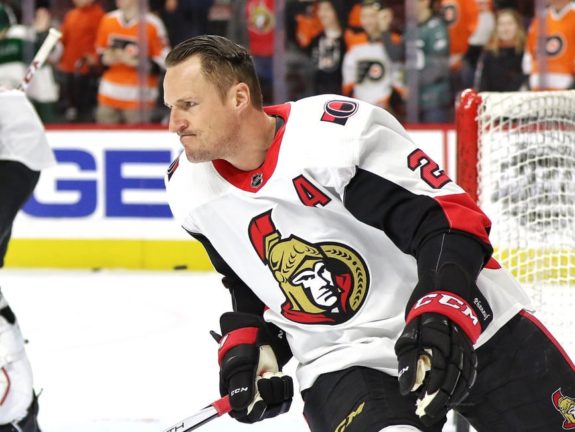
Phaneuf donated a lot of money to Ottawa charities with only one condition – that the charity keeps his donation a secret. He purchased tickets for disadvantaged fans to attend Senators games and he greeted them after each one.
Phaneuf was a media favourite because of his willingness to speak after even the Senators’ worst losses. TSN’s Ottawa-based commentator, Ian Mendes, told a story about Phaneuf’s kindness during his first year in Ottawa. (from ‘Dion Phaneuf’s complicated legacy in Ottawa’, TSN.ca 14/02/2018) The Senators and their wives were dining together at a restaurant and they asked the table beside them if they would be willing to move to another spot so the whole team could sit together. Before the other table could leave, Phaneuf went to them to say thanks on behalf of the team for agreeing to move. He was the only player to do so. Not only that, but he paid for their dinner and told them that he would pick up the bill for their after-dinner drinks if they wished to stay.
In February 2018, in the midst of a rebuild, Ottawa dispatched Phaneuf to the Los Angeles Kings. At the end of that season, at 34 years old, his NHL career came to an end when the Kings bought out the final two years of his contract.
The Measure of Dion Phaneuf
Phaneuf was a hockey talent who played almost his entire career in the crucible that Canada can be to hockey players. Although he did not scale the heights of Crosby and Ovechkin, he also never played on a team that had a legitimate shot at a Stanley Cup. It is difficult to say what he could have achieved had he been surrounded by the talent that played supporting roles to Crosby and Ovechkin in their unforgettable Stanley Cup winning performances.
Whatever the character flaws that defined a young Phaneuf, they do not reflect who he became, as a man and a leader after the Flames threw him away in that rash 2010 trade. After Calgary, he evolved steadily into the understated, quiet hockey hero that Canadians have always preferred.
Calgary is left to wonder what might have been . . .
You may also like:
- Flames & Maple Leafs Trade History Revisited
- Calgary Flames’ 2024-25 Bounce Back Candidates
- Flames Will Be Elite Team When New Arena is Built
- NHL Rumors: Blue Jackets, Oilers, Flames, Senators
- Top Contenders for 2025 Calder Trophy
